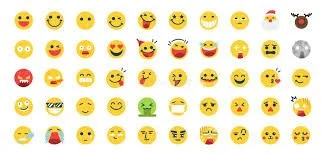Any curious art connoisseurs visiting the picturesque Museum of Modern Art at New York City might experience slight deja-vu at the sight of a glass-screen blipping with varied and minute pictograms. Designed by Japanese interface designer Shigetaka Kurita in 1999 to express emotions digitally, today these pictograms dominate the internet communication - we call them “emojis.” Expressing ourselves through language is complex - sometimes no word can embody our joy, no sound can reflect our grief - thus we have art. A thousand words may not be enough to articulate art; where language has failed, art has prevailed. Two decades after original emojis were unveiled, almost ten billion emojis are sent daily. They seem a small part of our lives, yet make online communication much livelier. As digital communication spread, so did use of emojis: across countries, cultures and cliques.
Originating in Japan, emojis imbibe a lot of local culture within. Kurita described ‘Manga’ - Japanese equivalent to comics - as his major inspiration for designing emojis. Take the emoji with veins popping up (💢), it usually denotes anger, or the nervous emoji (😅) or the exaggerated tears emoji (😭) for pain: all of which are heavily used in Manga. In fact anime - japanese animation - uses emoji-esque designs to show varied emotions as well. As emojis garnered global acceptance, different cultures flavored them according to their tastes. According to Kurita, the Ogre emoji (👹) representing “Oni” demons from Japanese folklore is used globally for signaling menacing mischievousness or playful devilishness. Depending on context, emoji interpretation varies as well. For instance, the person bowing emoji (🙇) sent to higher authority might mean sincere apology; sarcasm if sent among friends (or even pushups, if you are feeling rather health conscious). Emojis reflect societal changes as well: the sparkle emoji (✨), according to Kurita, was originally designed for signifying “shining new”, yet today it symbolizes AI technology - look at Google’s Gemini, Galaxy AI, Spotify’s “smart shuffle” feature as well as Zoom’s AI assistant. Emojis also act as symbols and signals for personal beliefs, nationality or the socio-cultural movements people support. For instance, accounts placing flag emojis beside their usernames on social media to represent their nationality.
Human behavior is primarily emotional in nature; thus emojis are capable of subtly influencing our affect and mood, they can be powerful tools for online emotional communication. For instance, placing a sad emoji while informing bad news or mistake can add to the gravity of the apology; a rude text with the smiling emoji might signal passive-aggressiveness; a barrage of positive emojis with good news signal excitement or a laughing emoji can cajole the latest unfunny joke your friend made (while you keep a poker face).Contrary to popular belief, research has found that leaders using more positive emojis increases positive emotions and creativity in team members. Emojis can become emotional contagions as well. Using positive emotions in texts can make the conversation more enjoyable, while excessive sad emojis might make the text conversation dull. Let’s begin a simple thought experiment. Assuming our actions reveal much more about us than mere words, we can form a hypothesis that the most used emojis by us might be reflective of our mental states as well - the first ten emojis suggested by our phones might be more significant than we previously thought.
A foreign tourist in China may not understand the language; though a smiling face is universally understood. Emotional expressions like smiling and frowning are independent of cultures, found in all human societies. Although many translation services are available today, emojis reflecting these universal emotions act as excellent communicators for basic emotions and even certain ideas or actions. A handshake emoji can convey cooperation cross-culturally, or a lightbulb emoji can represent a new idea. Emojis enable niche cultural exposure as well by sharing depicting cultural icons, landmarks, traditional clothing or simply local cuisine. A young kid in Europe stumbling upon the (🍜) emoji would want to know its meaning. Emojis are starting to vary depending on skin-color as well as a mark of cultural acceptance. However, cultural misunderstandings can still occur. Cultural sensitivity and emoji universality must be balanced.
Emojis (more than colorful icons)are micro-zeitgeists reflective of the contrasts and convergences between the webscapes of localized cultures and globalized world. Some people use them a lot, some may not use them at all. Some may consider them childish, some consider them essential. However, they are an important artifact of modern online communication, so much so that 17th July is considered to be “World Emoji Day🗺️🤩📆”.
Ejaz Shaikh


